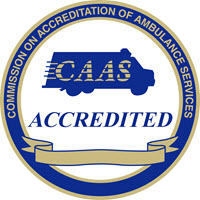The CAAS Standards Revision (2000)
In 1997, a Standards Revision Committee was formed, and work began on the 2000 Edition with a solicitation to all professional EMS organizations for updates. Input for the revision was received from agencies, associations, and individuals from around the country, making the new standards truly a product of the entire ambulance industry.
The committee approached the standard revisions with several goals in mind. They determined that the end product should continue to serve the primary purpose of Quality Improvement for EMS agencies, thus adding a strong Quality Improvement focus throughout. The committee also sought to bring a higher degree of consistency to the format and language of the original application. New topics were addressed in such areas as compliance programs, information systems, insurance coverage, and customer satisfaction.
The process used by the committee was based upon a traditional Continuous Quality Improvement method. Each standard characteristic was reviewed for its level of importance to determine if it should be included and updated or replaced by another. The root intent was described within the structure of each revised standard characteristic. From there, the result (or outcome) of meeting the standard was also described and included. The process by which an agency is to meet each standard was defined where indicated, but was also left flexible in many cases–encouraging agencies to determine the best methods for meeting their own needs.
The CAAS Standards Revision (2004)
In 2002, the CAAS Board of Directors responded to multiple requests for a mechanism to accredit ground Inter – Facility Transport (IFT) Specialty Care Transport (SCT) agencies and directed the formation of a multidisciplinary task force to craft standards. Twenty-seven individuals from across the nation volunteered to work on six subcommittees. Work was completed in early 2004. During the process, multiple areas in the overall standards that required refinement were also identified, and these ideas were incorporated, as well as other minor revisions that had been recommended. (All changes and revision in this 2.4 version of the CAAS standards are indicated with a NEW or Rev. 4/14/04 notice.)
After considerable debate, CAAS elected to utilize both the IFT and SCT terms in its revision. Inter – Facility Transport (IFT) services are defined as those agencies that regularly accept or plan for scheduled transports between healthcare facilities. Specialty Care Transport (SCT) service are defined as those agencies that regularly accept or plan for transports between healthcare facilities that are outside of an EMS provider’s normal scope of practice. There is a wide variation in IFT and SCT agencies that may be broad in scope or very limited (e.g. neonate transport services). The standards were written to be as inclusive of this diverse group as possible.
Using the IFT/SCT Standards
Agencies performing IFT are required to meet all CAAS standards, unless specifically exempted in the IFT portion of the standard characteristic.
Agencies performing SCT are required to meet the additional standards marked by SCT. There is an assumption that a different standard of care is inherent in these services than in primary emergency response agencies, and the additional SCT standards address that difference.
The agency is asked to self- determine whether it needs to meet these additional requirements (see Application Document, page 3). It is important to note, however, that for all application documentation received after June 1, 2005, site reviewers will have the obligation of applying the additional standards if they deem them relevant during their on-site review.
The CAAS Standards Revision v3.0 (2009)
In the autumn of 2008 CAAS begin its third standards revision process. Twelve individuals from across the country volunteered their time and expertise to review the existing standards, using input from EMS experts, CAAS agencies and site reviewers to update and expand the CAAS standards. The standards review committee focused on the refinement of existing standards, and increased safety and compliance requirements. All changes and revisions in this 3.0 version of the CAAS standards are indicated with a NEW or Rev.10/2009 notice.
This edition of the CAAS standards is dedicated to Dr. William “Bill” Jermyn, who passed away suddenly in May of 2008. Dr. Jermyn was a passionate CAAS Board Member and advocate for emergency medical services. Bill was a well loved and highly respected emergency physician with the unique ability to bring a diverse group of passionate people together to solve EMS and acute health care issues. He brought his physician expertise to the CAAS Board of Directors along with his expert knowledge of ambulance administration. He was a key contributor to the CAAS standards revision process in 2000 and served as the chair on the 2004 Specialty Care Transport standards revision committee responsible for the development of the version 2.5 CAAS standards. Additionally, Bill served as a mentor and role model for many of our site reviewers and staff members. Bill’s compassion, tenacity, and dedication to quality in EMS will truly be missed by our organization. The CAAS standards are a tribute to Bill and all he has done for emergency medical services.

